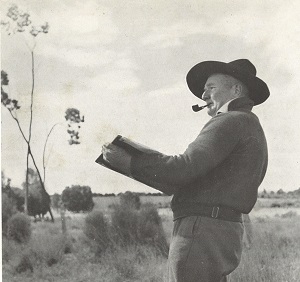IMPORTANT WORKS BY KENNETH MACQUEEN
‘I try in my work to express the joy of living […] Australia is not a sinister country, nor is she harsh. Her bush is not drab. It is full of gaiety if one will trouble to seek. She has her grim moods […] and there is always the glory of her skies, and when she smiles, it is of transcending beauty’.1
KENNETH MACQUEEN - Supplementary Image.jpg

KENNETH MACQUEEN
photo by Revan Macqueen
Kenneth Macqueen embodied the romantic figure of the farmer-artist, a man whose love and appreciation of the land upon which he lived shone through in his lyrical landscape paintings. With crisp light and line, and an astounding formal simplicity, Macqueen’s watercolours are patently modern, infusing in the genteel medium a dynamic vitality. The post-war decades in Australia were characterised by optimism, protectionism, and the creation of a national idiom in landscape painting, rehabilitating the impressionist ideal of the Australian pastoral.2 In attempting to adapt landscape painting to the specificities of the Australian environment and to the stylised techniques of Modern painting, Macqueen joined pioneering Sydney modernists Elioth Gruner, Roland Wakelin and Roy de Maistre, exhibiting with them annually at Society of Artists and Contemporary Group exhibitions.
After serving in the First World War, Macqueen returned to Australia and, with his brother, purchased a farm in Queensland’s Darling Downs. From 1922, the artist lived there, at Murralah, situated on the crest of a hill near Millmerran, working the land and enjoying its panoramic views of undulating hills and sweeping skies. Macqueen’s watercolours display a strong formalist and graphic impulse, featuring bold lines and panes of vibrant colour in semi-abstract compositions. Having mapped out the stylised forms of the landscape in pencil en plein air, Macqueen worked quickly in the studio, systematically applying wet-on-wet washes of watercolour pigment and often leaving areas of his white paper support untouched. The resulting patterns, while simple and easily legible, are characterised by a sense of freshness and spontaneity.
Forming a chronicle of life in rural Queensland, Macqueen’s subjects were an immediate and truthful depiction of his experience: planting, harvesting, ploughing and fencing. Finding solace in the monotony of rural life, Macqueen delighted in the stillness and expansive space. Bodumba Lands, 1927 is a crisp sweeping view of the immediate surrounds of Millmeran, with rolling peaks and contrasting strips of recently tilled fields. Farmer’s Fence, 1928, similarly traces the sinuous man-made profiles of a fence and worn path against a dramatic backdrop of a young crop of wheat and freshly ploughed hill. In the 1930s and 1940s, Macqueen made regular holiday trips to the Sunshine and Gold Coasts, creating dramatic paintings of the coastline and sea, as can be seen in Early Morning, 1934 and Sea and Reef, c.1938. Amongst the Paperbarks, a mature work focussed on formal patterns, explores the shadows and forms of a eucalypt forest, punctuated by a flowering banksia in the foreground.
1. Macqueen, K., Adventures in Watercolour, The Legend Press, Sydney, 1948
2. Edwards, D., ‘Landscapes of Modernity 1920s – 1940s’, Sydney Moderns, Art Gallery of New South Wales, 2012, p. 217
LUCIE REEVES-SMITH
BACK TO CATALOGUE